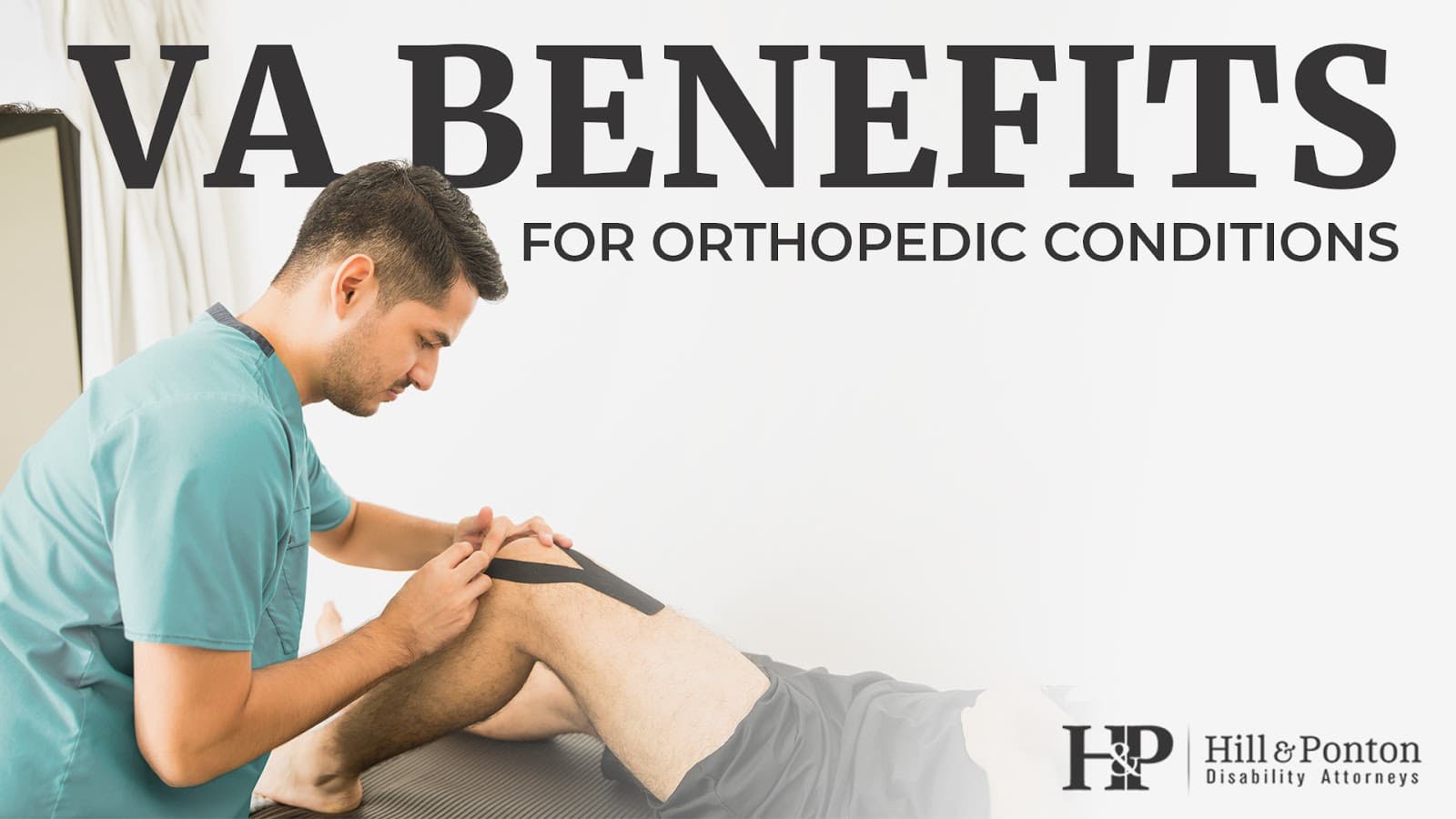VA Benefits for Orthopedic Conditions
Orthopedic conditions and injuries are common among veterans. Whether you’re experiencing a lower extremity fracture of degenerative joint disease, you may qualify for disability benefits through the United States Department of Veterans Affairs.
In order to make a disability claim for an orthopedic injury, veterans must undergo medical examinations and prove service connection. This guide will outline the basic of obtaining disability compensation for orthopedic conditions.
What Injuries May Qualify as Orthopedic Conditions?
Orthopedic conditions and orthopedic injuries include a wide range of issues–all pertaining to the musculoskeletal system. Disabled veterans often qualify for benefits due to injuries of the muscles, joints, and spinal column. Some of the most common orthopedic conditions include knee injuries (such as degenerative arthritis or patellofemoral syndrome), degenerative disc disease, fractures, and shinsplints. Amputations can also be rated as an orthopedic condition.
Proving Service Connection for VA Benefits for Orthopedic Injuries
The first method for obtaining service connection for orthopedic injuries is through primary service connection. To prove that an in-service incident caused your injury, you will need to provide the following:
- An in-service injury or event
- A current diagnosis for your in-service injury
- A medical nexus linking the orthopedic injury to the in-service incident
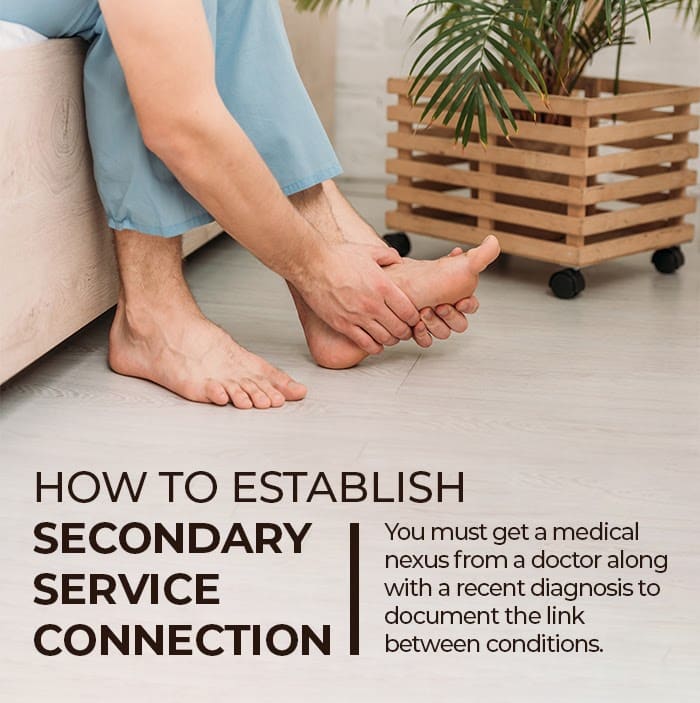
Secondary Service Connection
Some military veterans experience conditions after service that stemmed from their service-connected orthopedic injury. Since orthopedic injuries refer to conditions of the musculoskeletal system, these secondary conditions can vary greatly.
Depression is a common example, since mobility challenges and limitations may lead to mental health issues. Physical symptoms like headaches can also stem from injuries like neck injuries. In these cases, veterans may be able to claim depression and headaches through secondary service connection.
Service Connection Through Aggravation
If you had an orthopedic condition or injury before military service, but it became worse during service, you may still be qualified for disability benefits. To obtain these benefits, you will need to prove service connection through aggravation. This involves showing that an in-service occurrence aggravated the condition or caused it to progress more quickly. For example, you may have had a back injury that became worse after carrying heavy equipment during active duty.
How Does The VA Rate Orthopedic Conditions for Disability Benefits?
Orthopedic conditions are some of the most common conditions we see from veterans. The first step in determining service connection for a condition is establishing whether or not you have a current disability.
There are several symptoms that the VA will look for when assessing orthopedic conditions, which may include factors like pain and weakness. However, limitation of motion is one of the most common indicators. For orthopedic conditions, the VA will commonly use range of motion (ROM) testing to assess a current disability.
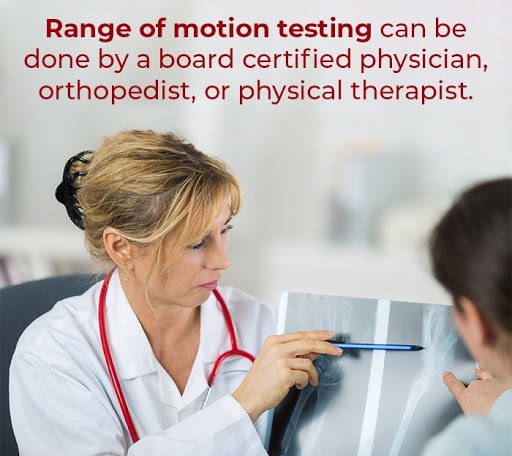
What is Range of Motion Testing?
Range of motion testing is a measurement of the distance and direction your joints can move to their full potential. It’s one of the most common This must be completed by a board certified physician, orthopedist, or physical therapist. The examiner must use a goniometer, which is an instrument that tests the angle of your joints.
Range of Motion Broken Down
Of course, joints can move several different ways. For example, the type of range of motion testing performed for the knee is as follows:
1. Flexion = the degree to which the knee can be bent (kicking backward from a standing or lying down position)
2. Extension = the degree to which the knee can be extended (extending the leg straight from a bent position)
Please keep in mind– this is not a complete list. Types of range of motion testing vary depending on the joint being measured.
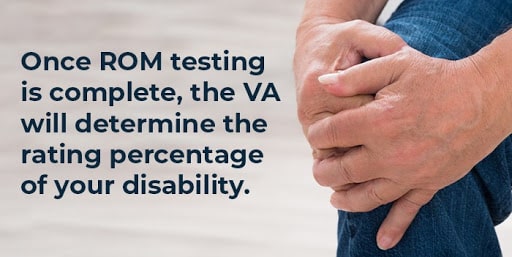
ROM Testing Was Done – Now What?
Once your ROM has been performed, the VA will use Diagnostic Codes or DCs to determine the rating percentage for your disability. These diagnostic codes are called by other names as well; we commonly refer to them as Rating Schedules or Rating Formulas. Basically, these are the statutes that determine what percentage level your condition disables you according to the VA. They range from anywhere to 0% to 100% depending on the condition. Ten percent is the lowest compensable rating, but 0% ratings are still assigned. With a 0% rating, the VA has recognized you have a service-connected disability, but they not believe it to be severe enough to warrant an award for it. Meaning, if you have a 0% rating, you will not receive any money for that condition.
For example, below is a portion of the Knee and Leg Diagnostic Code. The number to the left
“5260” is the Diagnostic Code (DC). The far right column is the rating percentage.
| 5260 Leg, limitation of flexion of: | |
| Flexion limited to 15° | 30 |
| Flexion limited to 30° | 20 |
| Flexion limited to 45° | 10 |
| Flexion limited to 60° | 0 |
The entire Electronic Code of Federal Regulations is public and can be found at https://www.ecfr.gov. VA information can be found under Title 38 in the dropdown box on the website.
Because these are federal statutes, the VA is required by law to adhere to them. Using the example above, if you have a service-connected knee or leg condition that limits your range of motion (ROM) of flexion to 30° you are entitled to compensation at the 20% rate.
Can You Receive a 100% VA Disability Rating for Orthopedic Conditions?
Some veterans may qualify for a 100% VA disability rating for their orthopedic injury. This may be the case if you sustained more than one injury that add up to a 100% rating.
Some veterans may also qualify for TDIU for their injuries if they are unable to work due to their condition. To qualify for TDIU, veterans must have:
- A single-condition rating of at least 60%, or;
- a combined rating of at least 70%.
Veterans with amputations may qualify for special monthly compensation for loss of use.
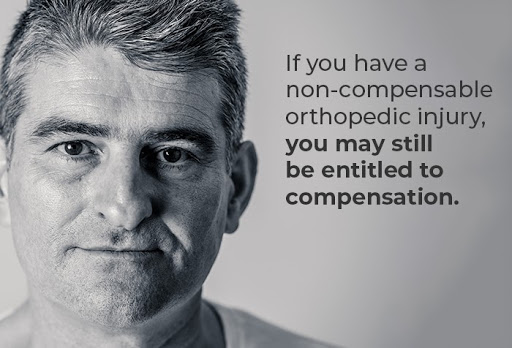
What If I Have An Orthopedic Condition but Don’t Meet the ROM Requirements?
Do not fear! If you have an orthopedic condition that isn’t compensable (a 0% rating) but still affects your ability to properly function, you may still be entitled to compensation. The VA uses a term called “functional loss.” As outlined in CFR § 4.40, functional loss is the inability to perform the normal working movements of the body with normal excursion, strength, speed, coordination and endurance. If normal range of motion causes you pain that contributes to functional loss, you may still be entitled to compensation! We will dive into this further in Part 2.
Tune into Part 2 of this blog series to see how you can be awarded for your arthritic orthopedic condition based on painful range of motion.
Have Questions About VA Disability Benefits for Orthopedic Conditions?
If the VA has denied your claim for disability compensation for your orthopedic injury, contact the team at Hill & Ponton. Our veterans disability lawyers are here to assess your claim and represent you, so you can obtain benefits. Click the red button above for a free case evaluation.
